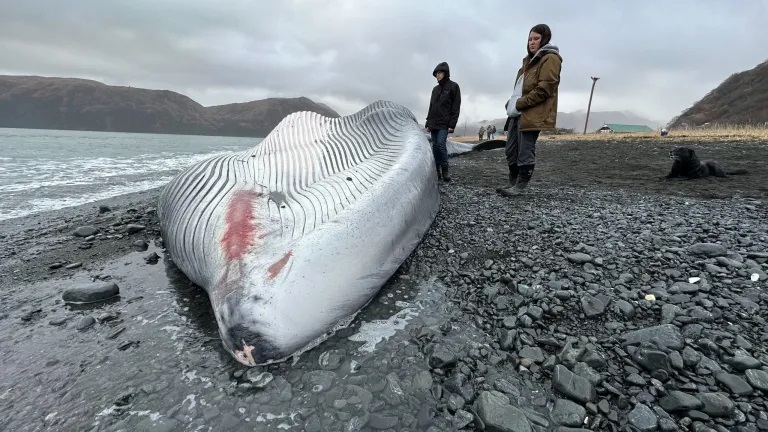A fin whale, the second-largest whale species globally, was discovered washed ashore in the Pasagshak State Recreation Area, near the end of Kodiak Island’s road system. The whale, found in late November, exhibited signs of severe emaciation and poor health, prompting concerns among local authorities and scientists.
Fin whales are typically rare around Kodiak, making the discovery of an emaciated specimen even more alarming. Matt Van Daele, the natural resources director for the Sun’aq Tribe in Kodiak, reported that the whale, estimated to be between 10 and 14 years old, showed extreme signs of malnutrition, resembling a “53-foot-long snake.” The cause of death remains unclear, but the whale’s emaciated state and multiple bruises on its body raise questions about its well-being before stranding.
The Sun’aq Tribe, along with approximately 40 volunteers, veterinary staff, and tribal members, conducted a necropsy on the stranded fin whale. The examination aimed to gather crucial data about the whale’s health, potential causes of death, and any underlying environmental factors contributing to its condition.
This incident follows a similar necropsy conducted by the Sun’aq Tribe in September on a humpback whale, indicating a concerning trend of unhealthy whale strandings near Kodiak. While it’s premature to declare a trend based on limited data, the proximity of two malnourished whale cases in a single year raises concerns among scientists.
The recent events occur against the backdrop of an unusual mortality event for gray whales in the Pacific Ocean. The Sun’aq Tribe’s efforts to monitor and analyze whale populations are crucial for understanding potential threats and ensuring the well-being of marine life in the Kodiak Archipelago.
Biologists are eagerly awaiting laboratory results from the necropsies, hoping to shed light on the factors contributing to the poor health of these whales. The discovery of emaciated whales prompts worries about the overall health of marine populations in the region.
Despite the somber circumstances, the Sun’aq Tribe is planning to preserve the fin whale’s skeleton as a community landmark. Given that no other location in Alaska possesses a fin whale skeleton, the tribe aims to bury the carcass, allowing it to decay naturally over several years until only the skeleton remains. The hope is that displaying the whale’s skeleton will not only contribute to scientific understanding but also serve as a source of community pride for Kodiak residents.
